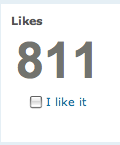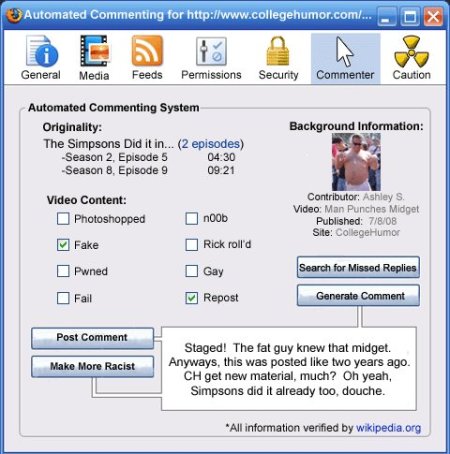Conrad Schoenleber – CollegeHumor.com
CollegeHumor.com: Online Interaction and Created Opportunities
CollegeHumor.com (CH) is an example of a virtual community that changes the way communities are defined and maintained. Sites like CollegeHumor connect people regardless of their physical locations, allowing a new way to create and continue personal relationships. CollegeHumor links to the already existing communities of colleges and universities, allowing students to consume and discuss content that they have a real-world connection to. Embracing Web 2.0, CollegeHumor is an interactive humor site fueled by user created content and discussion.
Overview:
Collegehumor.com is a website focused on delivering daily humorous content including videos, pictures, articles, jokes and links. The content on the site is created and curated by CollegeHumor staff and users. The site was created in 1999 by longtime high school friends Ricky Van Veen and Josh Abramson. According to Fox News, “[We wanted to start] an advertisement-based business,” Abramson said, “because at the time the advertising market was pretty hot and we’d seen other people develop Web sites that were popular making a lot of money.” Their aim was to create a humor site that would appeal to the advertiser-friendly college-aged demographic.^ Carothers, Carrie (2006-06-15). “Business at Collegehumor.com Is No Joke”. Fox News. Retrieved 2009-12-13.
This advertising-friendly model has been very effective. The most visited humor site on the internet, CH receives over 6 million independent visits each month with over 1.5 million registered users. CH has also been successful offline with two published books and two television shows. The decidedly unfunny “CollegeHumor Show” featured the staff of CH in a sitcom like show, similar in format toThe Office but with popular videos from the site mixed in. The show lacked direction and was canceled after one season. The currently airing show “Pranked” features Streeter and Amir, two of the CH office staff and stars of their online videos, counting down the greatest prank ever caught on camera and uploaded to the internet. They were chosen for this job because of their participation in what CH is best known for, the “Prank War” videos in which they attempt to upstage each other with increasingly elaborate and embarrassing pranks. This series of videos eventually got them featured on CNN and raised CH’s visibility significantly, gaining more fans and users of the site. CH also pioneered the now widespread “Like” system. When a user enjoyed a piece of content on the site they would click the like button, which is then tabulated. The more “likes” the more popular.
Already Existing Communities:
In order to become a member of CollegeHumor, a user must have a college or university e-mail address. Other users may sign up as well, but they will not be able to upload content or participate in other aspects of the site. This ensures that the majority of users are college students. On each users profile (this is my profile), comments and any uploaded content, the users name and school are prominently displayed. Content itself is organized by school, allowing the user to see what all members of their school have contributed. Tapping into school pride, CH will have competitions over which school can submit the most videos, pictures and articles. What school you attend is often brought up in the comments section, thus just as users wish their school to have a good real-world standing, they also do online. Much of CollegeHumor’s content focuses on student issues as well. For example, in an act of solidarity with college students the staff of CollegeHumor stay up all night, creating and releasing a funny video every hour during the annual “all-nighter”.
Another example is the weekly “Parents Just Don’t Understand” articles wherein students submit stories of their parents having problems with technology.
Real-World issues that are not always comedic are often focused on and discussed. One such example is the NYU “Sit-In Disaster” video. During February last year, members of an NYU student group barricaded themselves in a cafeteria and would not leave until their list of demands had been met. The demands were completely unreasonable and ridiculous and the whole operation seemed like the idiotic brain-child of pampered and naive college students. Failing to understand how breaking the law is different then having a peaceful protest, the last minute of the protest were caught on video with painful results:
This video was extensively ridiculed by CH commenters, thereby ruining any from NYU’s reputation within the community. Even a year later a user will be made fun of for being from NYU. Things like school sports and going ons are also discussed by the CH community. The real-world issues of college life are an integral part of the CH community.
Commenting, Success and Self-Promotion
Even though the majority of the content is user generated, that does not mean that all user content makes it to the front page or is viewed by the CH community. When an article is submitted it goes through a peer review process. At first the piece must deemed as appropriate by the CH staff and falling within the sites terms of use. After that it starts in a User’s profile until it gains enough “Likes”. If a piece gains enough likes it moves up the site’s hierarchy as follows:
-User’s Profile
-User’s School Page
-Article Section
-Front Page – “Nationally Published”
As a “like” is simply someone saying that they enjoyed the piece, if enough people enjoy it it will eventually be published nationally. Once a piece is published nationally CollegeHumor offers an incentive program based on the amount of page views a piece accrues as follows:
-100,000 = $50
-150,000 = $150
-200,000 = $200
-250,000 = $250
If a user wishes to be successful and make money from their articles they first have to make sure that people are reading them. If no one can see your work because it isn’t being published on the front page then you will never make any money. Thus visibility and gaining “likes” is critical. The easiest way to do this is through commenting. The commenting community on CH is dedicated and often more entertaining than the actual content itself. Like any other community, one must work their way up through the ranks of the commenting community. One way is to post frequently and reply to other comments. However being a frequent commenter isn’t enough. There are many people who comment frequently, but do not write anything creative or funny. In fact commenters and comments have been boiled down into specific stereotypes:
In order to differentiate oneself from these masses and gain more visibility, one must be witty. If one is effectively witty and posts frequently they will benefit as such:
-More Comments = More Profile Views
-More Profile Views = More Content Exposure
-More Content Exposure = (Hopefully) More Likes
The success of the user and their material is dependent on the CH community. As is true in almost any community, any who is well liked and respected is more likely to be successful. In fact, if a user is successful and popular enough CH will often offer them employment. The majority of the full time CH staff started out as users. I can personally attest to this as I wrote an article that eventually went national and was then offered employment by CH writing captions and jokes. Users are empowered knowing that they can get a job based on the merit of their work.
Issues Regarding CollegeHumor:
Although CollegeHumor is a very successful Virtual Community it is not without issues. Users must deal with the issue of mediated communication and interaction. CH’s asynchronous commenting forums can allow problems with interpretation and representation. A users meanings and intentions can become misinterpreted or lost. The delayed interaction of commenting means that a user must get what they intended to say across correctly the first time. In effect, you must be funny with your first post. It is possible for someone who is genuinely funny and creative to be ignored if they do not comment well. The technological platform of CH shapes the way that users interact. In order to be successful, a user must learn to work with the platform.
Conclusion:
Virtual Communities are changing the way that we form and experience communities. A website like CollegeHumor capitalizes off of this and becomes very successful as a result. By embracing the new ways the communities are defined CollegeHumor has become the must visited humor site on the internet with millions of viewers and users. As people become more and more comfortable with the internet, virtual communities will be increasingly prevalent. While virtual communities do provide real and meaningful interactions, they do not replace real life interaction. As the technology behind virtual communities advances, it will be interesting to see how people try to balance their online and real world lives. This is an issue that many people struggle with already. Kevin Slane, a user on CollegeHumor exemplifies this perfectly. Slane was a user that commented on absolutely every piece of content that was put up. People noticed this and begin to comment on it. Kevin Slane eventually became ostracized because he was accused of not having a life outside of CollegeHumor. Virtual communities provide a new way to connect with others, but there must be a correct balance.
Sources:
(1) Carothers, Carrie (2006-06-15). “Business at Collegehumor.com Is No Joke” Fox News
(2) 11th Annual Webby Awards Nominees: 2007″. The Webby Awards.
(3) College Humor’s Original CHTV section”. collegehumor.com
(4) College Humor’s FAQ section. Collegehumor.com/articles/faq
(5) About Connected Ventures. Connected Ventures LLC
About the author:
My name is Conrad Schoenleber and I’m a junior at the University of Minnesota. I’m a Cultural Studies major and hoping to become a culture writer or music critic. I DJ and am involved with the Minneapolis music scene and hope to find a way to include my love of music with future jobs and prospects.





Leave a comment